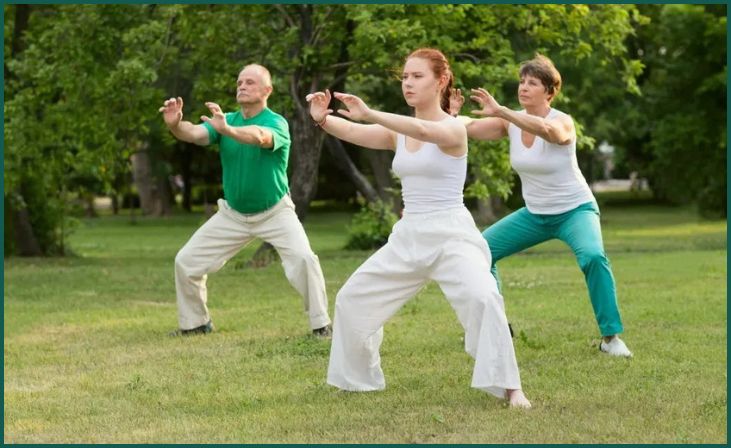Workouts To Regain Your Balance – Regaining balance isn’t just about preventing falls—it’s about enhancing your overall physical performance. Whether you’re an athlete looking to improve agility or a senior aiming to prevent accidents, these 7 Best Workouts are your path to stability. Our curated list combines flexibility, strength, and coordination exercises, designed to target your core and enhance proprioception. From yoga poses that challenge your equilibrium to core-stabilizing Pilates routines, we’ve got you covered. Enhance your sense of equilibrium, build a stronger core, and improve your posture with these proven methods. Say goodbye to wobbly steps and hello to confidence in motion. Embrace these workouts as more than just exercises—they’re tools for a balanced, healthier lifestyle.
Table of Contents
Toggle7 Best Workouts To Regain Your Balance
1. Yoga Poses for Stability and Flexibility

Yoga offers a myriad of poses that challenge your balance while improving flexibility. Poses like Tree Pose (Vrikshasana) and Warrior III (Virabhadrasana III) not only engage your core but also enhance proprioception—the body’s sense of its position in space. Incorporating yoga into your routine can help build strength in the stabilizing muscles of your legs and core. Additionally, poses such as Half Moon (Ardha Chandrasana) and Eagle Pose (Garudasana) promote focus and concentration, crucial elements of balance. These yoga postures not only improve physical stability but also cultivate mental clarity, making them an excellent addition to any balance-focused workout regimen.
Also Read: Top 7 Morning Strength Exercises to Accelerate Loss of Weight
2. Pilates: Core-Strengthening and Stability Training
Pilates is known for focusing on making the core strong and stable. The exercises in Pilates target the deep muscles of the abdomen, back, and pelvis—key players in maintaining balance. Moves like the Hundred, where you engage your core while pumping your arms, and the Single Leg Circle, which challenges stability while working the core, are staples in Pilates routines. By consistently practicing Pilates, you not only develop a stronger core but also improve your body awareness and alignment. These benefits translate directly to better balance in everyday movements, whether you’re reaching for something high on a shelf or navigating uneven terrain during a hike.
3. Balance Exercises: Simple Yet Effective
Simple balance exercises can be incredibly effective in improving stability. The classic Single Leg Stance, where you stand on one leg for increasing durations, is an excellent starting point. As you progress, you can challenge yourself with variations such as closing your eyes or incorporating arm movements. Another beneficial exercise is the Tandem Walk, where you walk heel-to-toe along a straight line, mimicking a tightrope walker. This exercise not only strengthens the ankles and calves but also enhances coordination and balance. Incorporating these basic balance exercises into your daily routine can yield significant improvements in stability and overall body control.
4. Tai Chi: Fluid Movements for Balance and Harmony

Tai Chi, an ancient Chinese martial art, focuses on slow, deliberate movements that flow from one to the next. These gentle, flowing motions promote balance, flexibility, and relaxation. Tai Chi routines often include shifting your weight from one leg to another, which helps improve stability and coordination. The controlled breathing techniques integrated into Tai Chi also contribute to a sense of calmness and focus, essential for maintaining balance. Studies have shown that regular practice of Tai Chi can reduce the risk of falls in older adults by improving balance and muscle strength. Embrace the graceful movements of Tai Chi to regain your balance while fostering a sense of harmony between body and mind.
Don't just scroll, subscribe!
BuzzTrail's unique web-stories are the cure for boredom you've been waiting for.
5. Stability Ball Workouts: Engage Your Core
Incorporating a stability ball into your workouts can add an extra challenge to your balance routine. Stability ball exercises, such as seated balance holds or plank variations with your feet on the ball, require constant engagement of the core muscles to maintain stability. By using an unstable surface, like the stability ball, you activate the smaller, stabilizing muscles that are often neglected in traditional workouts. This not only improves your balance but also enhances overall core strength and stability. Whether you’re a beginner or a seasoned fitness enthusiast, the stability ball offers a versatile and effective tool to elevate your balance workouts to the next level.
6. Strength Training: Building a Solid Foundation
Strength training plays a crucial role in improving balance by enhancing muscle strength and coordination. Compound exercises like squats, lunges, and deadlifts engage multiple muscle groups simultaneously, mimicking real-life movements that require balance. By progressively increasing the weight or resistance in these exercises, you challenge your muscles to adapt and grow stronger, leading to improved stability. Additionally, exercises that target the muscles of the lower body, such as calf raises and leg curls, directly contribute to better balance and agility. Incorporate strength training into your routine to build a solid foundation of muscle strength, essential for maintaining balance in all aspects of life.
7. Dance Workouts: Fun and Functional Balance Training

Dance workouts offer a fun and engaging way to improve balance while burning calories. Whether it’s salsa, ballet, or Zumba, dancing requires constant shifts in weight and coordination, challenging your balance in dynamic ways. The quick steps, turns, and twists of dance routines engage the core muscles, legs, and stabilizing muscles throughout the body. Over time, regular dance practice can lead to increased stability, better posture, and improved coordination. Additionally, dancing releases endorphins, the feel-good hormones, promoting a sense of well-being and reducing stress—a bonus for both body and mind. So put on your dancing shoes and groove your way to better balance and a healthier you!
Also Read: 7 Compound Exercises to Strip Away Love Handles
Conclusion
Incorporating these 7 Best Workouts into your fitness regimen isn’t just about finding steadiness on your feet—it’s about embracing a holistic approach to health. By enhancing your balance, you’re strengthening your core, improving posture, and boosting overall well-being. Whether you’re an experienced athlete or new to the fitness scene, these exercises offer something valuable for everyone. Take charge of your stability journey and experience the empowering effects of improved balance. From the tranquility of yoga to the precision of Pilates, each workout brings you closer to a more centered and confident you. Embrace these exercises not just as a means to prevent falls, but as a pathway to a more agile, stronger, and more balanced self. Step into a world where every move feels steady and every moment, grounded.
FAQs
What are the benefits of improving balance?
What are the benefits of improving balance?
Improving balance enhances coordination, reduces the risk of falls, boosts athletic performance, and promotes better posture. It also helps in everyday activities, like walking and climbing stairs.
Can these workouts be done at home without equipment?
Can these workouts be done at home without equipment?
Yes! Most of these workouts require minimal or no equipment. Yoga poses, balance exercises, and Pilates routines can be easily done at home, making it convenient to incorporate into your daily routine.

